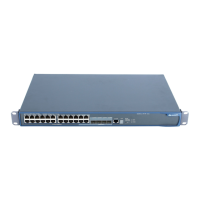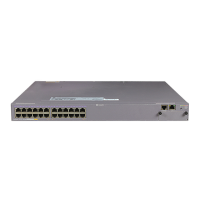Operation Manual – GVRP
Quidway S5600 Series Ethernet Switches-Release 1510 Chapter 1
GVRP Configuration
Huawei Technologies Proprietary
1-2
attribute information to be registered can be propagated to all the switches in the same
switched network.
GARP uses the following timers:
z Hold: When a GARP entity receives a piece of registration information, it does not
send out a Join message immediately. Instead, to save the bandwidth resources,
it starts the Hold timer, puts all registration information it receives before the timer
times out into one Join message and sends out the message after the timer times
out.
z Join: To transmit the Join messages reliably to other entities, a GARP entity sends
each Join message two times. The Join timer is used to define the interval
between the two sending operations of each Join message.
z Leave: When a GARP entity expects to unregister a piece of attribute information,
it sends out a Leave message. Any GARP entity receiving this message starts its
Leave timer, and unregisters the attribute information if it does not receives a Join
message again before the timer times out.
z LeaveAll: Once a GARP entity starts up, it starts the LeaveAll timer, and sends out
a LeaveALL message after the timer times out, so that other GARP entities can
re-register all the attribute information on this entity. After that, the entity restarts
the LeaveAll timer to begin a new cycle.
II. GVRP port registration mode
GVRP has the following three port registration modes: Normal, Fixed, and Forbidden.
z Normal: In this mode, a port can dynamically register/deregister a VLAN and
propagate the dynamic/static VLAN information.
z Fixed: In this mode, a port cannot register/deregister a VLAN dynamically. It only
propagates static VLAN information. That is, a trunk port only permits the packets
of manually configured VLANs in this mode even if you configure the port to permit
the packets of all the VLANs.
z Forbidden: In this mode, a port cannot register/deregister VLANs. It only
propagates VLAN 1 information. That is, a trunk port only permits the packets of
the default VLAN (namely VLAN 1) in this mode even if you configure the port to
permit the packets of all the VLANs.
III. GARP operation procedure
Through the mechanism of GARP, the configuration information on a GARP member
will be propagated to the entire switched network. A GARP can be a terminal
workstation or a bridge; it instructs other GARP member to register/unregister its
attribute information by declaration/recant, and register/unregister other GARP
member's attribute information according to other member's declaration/recant.
The protocol packets of GARP entity use specific multicast MAC addresses as their
destination MAC addresses. When receiving these packets, the switch distinguishes

